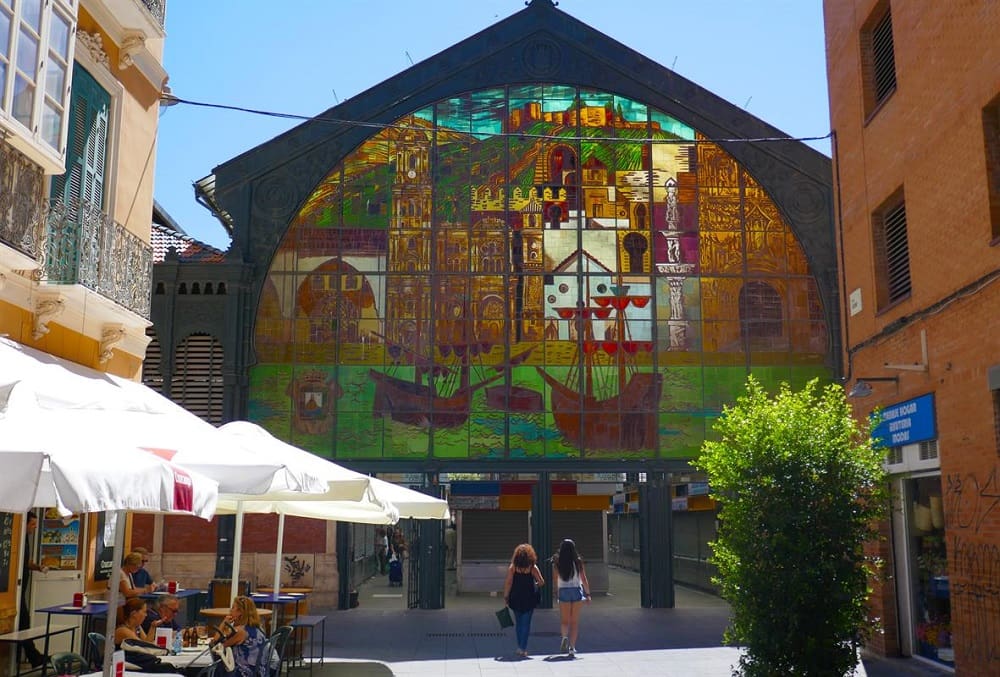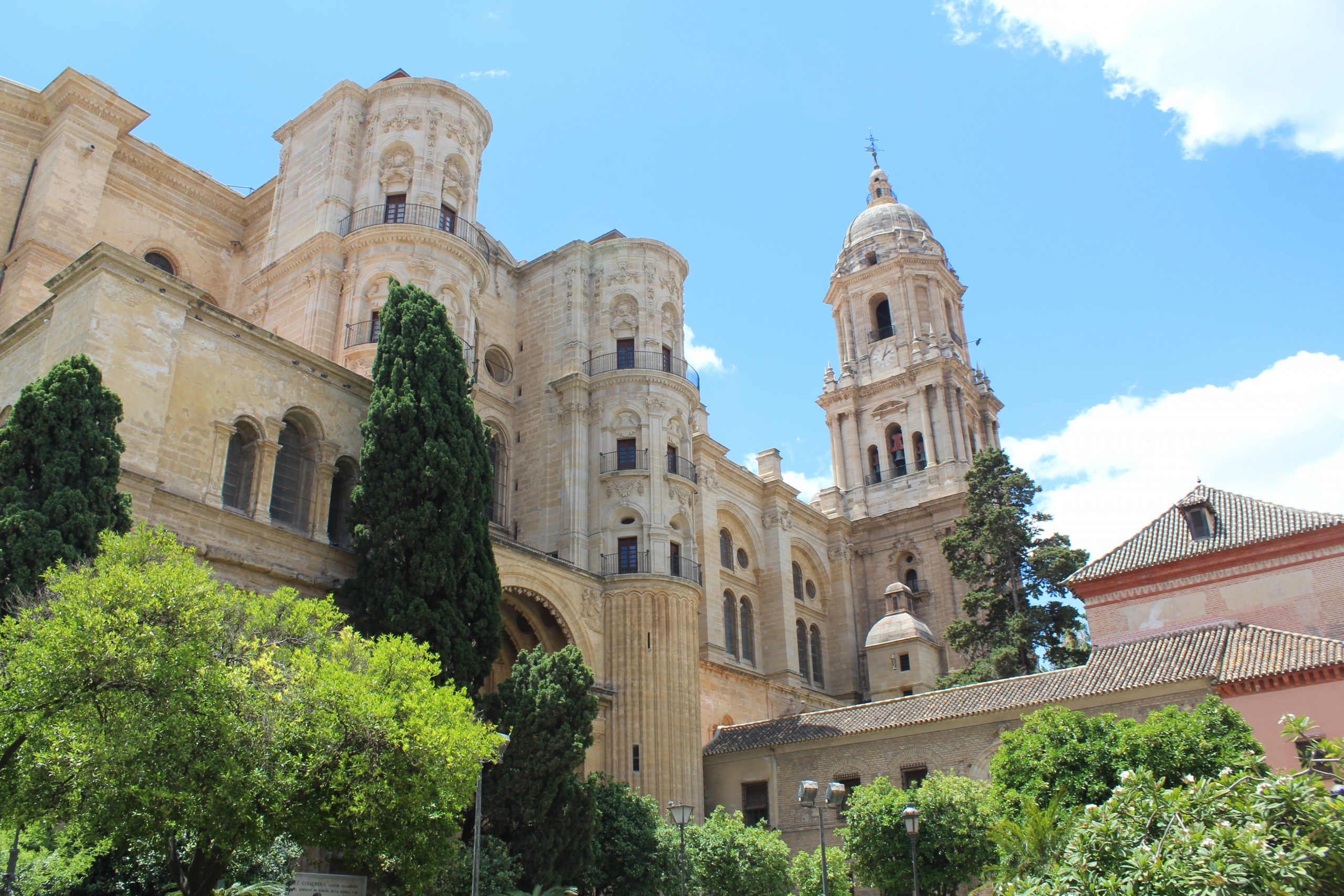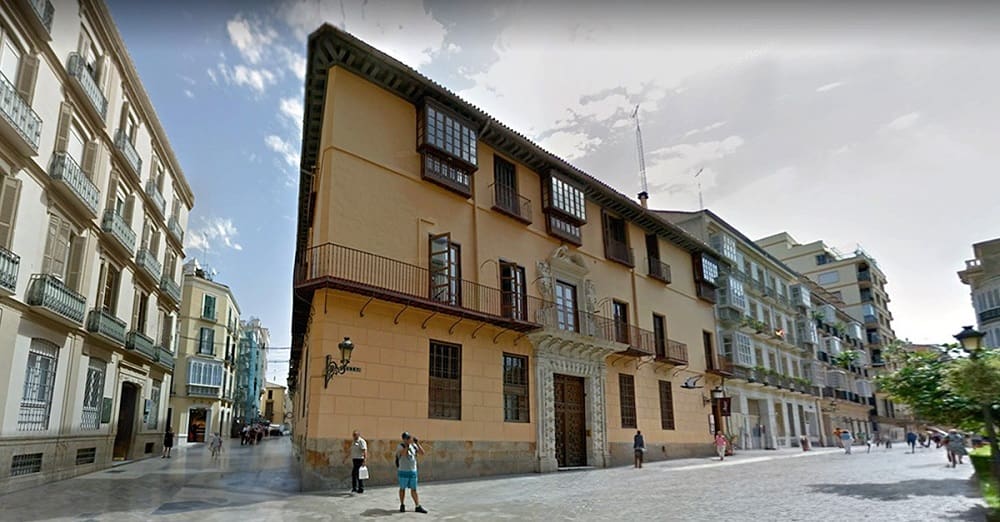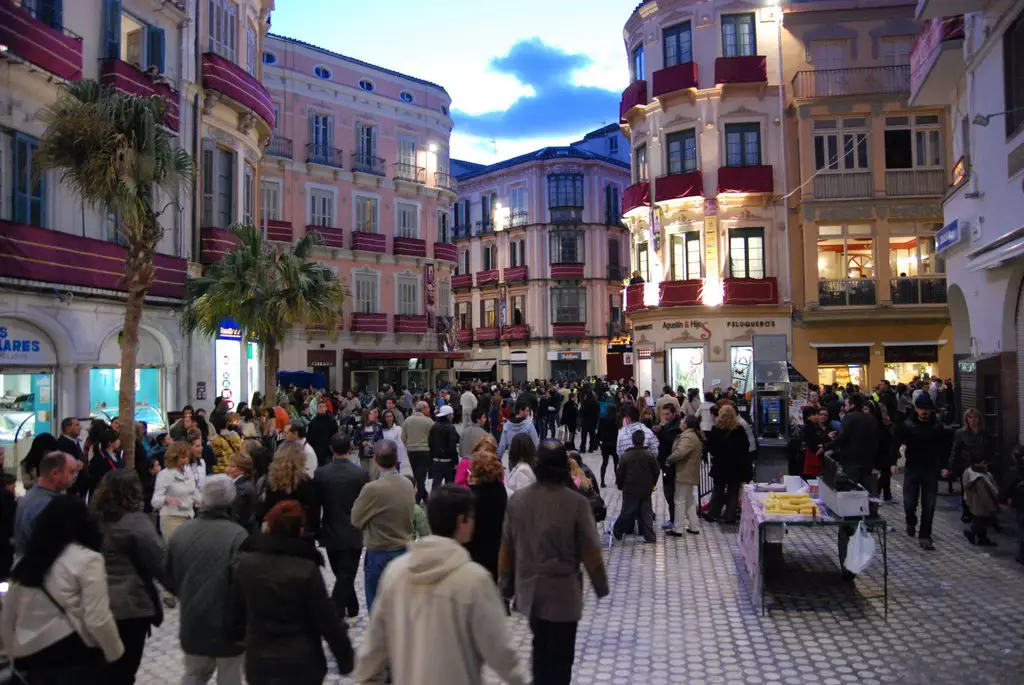

Enrique Sanchez
“Experience the best: Malaga’s Historic Center”
Carlos Garcia, a son of Malaga, is your personal guide to the city’s rich history and vibrant culture. A historian by training and a storyteller by passion, Carlos has spent his life exploring the city’s hidden corners and uncovering its secrets. His love for Malaga is infectious, and his knowledge of the city’s historic center is unparalleled. Join Carlos as he takes you on a journey through time, exploring the city’s past and present through its iconic landmarks and hidden gems.
Welcome to Malaga, a city where the whispers of the past blend seamlessly with the rhythm of the present. At the heart of this vibrant city lies its historic center, a captivating area that serves as a living testament to Malaga’s rich and diverse past. Enclosed by the Alameda Principal to the south, the Guadalmedina River to the west, Calle Parras to the north, and the Mediterranean Sea to the east, this area is a testament to Malaga’s rich history and vibrant culture. As we embark on this journey through time, we will explore the stories etched in the stone of Malaga’s historic center, stories of ancient civilizations, of artists and warriors, of traders and explorers. So, let’s take a step back in time and discover the charm of Malaga’s historic center.
Landmarks of Malaga’s Historic Center: A Walk Through History and Time
The historic center of Malaga is a treasure trove of architectural marvels and cultural landmarks. As we stroll through its pedestrian-friendly streets, we encounter a rich tapestry of history that unfolds in the form of churches, convents, and palaces, each holding tremendous cultural and artistic value. But to truly appreciate the charm of these landmarks, we must delve into the history of the city center itself, a captivating tale that spans over 2,800 years.
Our journey through history begins in the 7th century BC, when the Phoenicians, a seafaring people from the eastern Mediterranean, founded a commercial center they named Malaca. The Phoenicians were later succeeded by the Carthaginians in the 3rd century BC, who continued to develop the city.
In the 2nd century BC, the Romans colonized Spain and took control of Malaga. They expanded the city, building a theater, an amphitheater, and public baths, many of which can still be seen today. The Roman influence is evident in the city’s architecture and urban layout.
The Moors, who arrived in the 8th century AD, left a significant impact on Malaga. They fortified the city, built palaces, and introduced advanced irrigation systems. The Alcazaba, a Moorish fortress that still stands today, is a testament to their architectural prowess.
In the 15th century, the Christian Reconquest led to significant changes in Malaga. The city’s mosques were converted into churches, and new buildings were constructed in the Gothic, Renaissance, and Baroque styles. The city continued to grow and develop, eventually becoming the vibrant cultural hub that it is today.
Your Spanish Journey Starts Here: Buenos Aires, Malaga, or Anywhere You Are
Are you ready to embark on a language adventure that’s as exciting as it is educational? Whether you’re yearning for the vibrant city life of Buenos Aires, the sun-drenched charm of Malaga, or the convenience of online learning, we’ve got just the ticket!


Learn Spanish Online
Can’t travel right now? No problem! Our online Spanish classes bring the language, culture, and fun right to your living room. Engage with our experienced teachers and enjoy interactive lessons from wherever you are in the world.
www.vamospanish.com/online-spanish-classes/


Learn Spanish in Malaga
Imagine yourself soaking up the Andalusian sun as you learn Spanish in Malaga. Our school offers a unique blend of top-notch education and laid-back beach vibes. It’s not just a language course – it’s your passport to the Mediterranean lifestyle!
www.vamospanish.com/spanish-school-malaga/


Learn Spanish in Buenos Aires
Dive into the heart of Argentina with our Spanish school in Buenos Aires. Experience the city’s pulsating energy, rich history, and captivating culture as you master the Spanish language. Buenos Aires is calling – will you answer?
www.vamospanish.com/spanish-school-buenos-aires/
The Architecture of Malaga’s Historic Center: A Blend of Styles and Eras
The architecture of Malaga’s historic center is a fascinating blend of styles and eras, reflecting the city’s rich history and cultural diversity. From Roman ruins to Moorish fortresses, Renaissance cathedrals to modernist buildings, the city’s architecture is a visual narrative of its past.
The Romans left a significant architectural imprint on Malaga. The Roman Theater, located at the foot of the Alcazaba, is one of the city’s oldest monuments. Built during the reign of Emperor Augustus, it was in use until the 3rd century AD. Today, it stands as a testament to Roman architectural prowess and urban planning.
The Moorish era, which spanned from the 8th to the 15th century, introduced a new architectural style to Malaga. The Alcazaba, a Moorish fortress, is a prime example of this. With its robust walls, beautiful gardens, and intricate designs, the Alcazaba showcases the unique blend of functionality and aesthetics characteristic of Moorish architecture.
Also read our blog about: The Influence of Moorish Architecture in Andalusian Cities
The Renaissance period brought a wave of architectural transformation to Malaga. The Málaga Cathedral, also known as La Manquita, is a stunning example of Renaissance architecture. Its grandeur, intricate designs, and the unfinished south tower that gives it its nickname, “The One-Armed Lady,” make it a must-visit landmark.
In the 19th and 20th centuries, Malaga saw the rise of modernist and contemporary architectural styles. Many buildings in the city center, designed by architects like Fernando Guerrero Strachan, showcase this transition. These buildings, with their innovative designs and functional features, add a modern touch to the city’s historic center.
The architecture of Malaga’s historic center is a visual journey through the city’s history. Each building, each monument, tells a story of the people who lived here and the cultures they brought with them. So, as you walk through the city’s streets, take a moment to appreciate the architectural marvels that make Malaga’s historic center a living museum of its past.
The Most Important Buildings in Malaga’s Historic Center
Malaga’s historic center is home to several significant buildings that reflect the city’s rich history and architectural diversity. Here, we will explore some of the most important ones:
Alcazaba: A historic center’s gem
The Alcazaba is a Moorish fortress that dates back to the 11th century. It is one of the best-preserved Alcazabas in Spain. The fortress offers stunning views of the city and the Mediterranean Sea. Its robust walls, beautiful gardens, and intricate designs showcase the unique blend of functionality and aesthetics characteristic of Moorish architecture.
According to Arab historians, the Alcazaba was built between 1057 and 1063 at the instructions of Badis, King of the Berber Taifa of Granada. Columns, capitals, and other materials were taken from the nearby Roman Theatre to construct the fortress. Over the centuries, the Alcazaba remained under the rule of various Muslim dynasties, each leaving their mark on the fortress.


In 1487, the Alcazaba encountered its first major siege by Catholic military forces. For four months, the Muslim army, formed of 15,000 men, resisted an army of 80,000 until finally surrendering. The fortress was maintained in good conditions until the seventeenth century when two events contributed to its deterioration: the severe earthquake of 1680, and the damage caused by an attack by French ships in 1693 during the Nine Years’ War. From then on, the fortress was employed for various uses, including a prison, hospital, and even homes located on the lower part, until the thirties when rehabilitation work began and the compound was declared Historical Heritage of Spain, now an Asset of Cultural Interest.
Today, the Alcazaba spans 15,000 square meters and can be visited by climbing up on foot or by taking the lift from Calle Guillén Sotelo in front of the City Hall building. The Palace is structured around three courtyards, the first of which is the Los Surtidores courtyard, which has a central fountain and original arches from the Caliphate period. From the courtyard, you can access Armadura Mudéjar Tower which has a wooden coffered ceiling from the sixteenth century and a detailed model of the Alcazaba, as well as Maldonado Tower, which offers beautiful panoramic views of Málaga. From here you will come to the outstanding Nasrid Palace and its beautiful Orange Tree Courtyard.
On the way down from the Alcazaba, visitors can stop to see the Roman Theatre that was discovered right at the foot of the fortress in 1951. Right next to it is a visitors’ center that has information about the history of the theatre that was built in the 1st century AD and was plundered by the Moors centuries later to build the Alcazaba.
The Alcazaba’s military components make it one of the most important Muslim works in Spain today. It has been restored several times, most recently in the 20th century, and today the building and its important archaeological legacy can be visited, making it a living testament to the rich history and architectural prowess of the past.
Castillo de Gibralfaro: The historic center’s heart
Perched on a hill overlooking the city, the Castillo de Gibralfaro is a testament to Malaga’s strategic importance throughout history. Built in the 14th century, this castle was once a military stronghold. Today, it offers panoramic views of Malaga and houses a small museum dedicated to its history.
The site of the Castillo de Gibralfaro has been the location of fortifications since the Phoenician foundation of Málaga city, around 770 BC. The location was fortified by Caliph Abd-al-Rahman III in 929 CE. At the beginning of the 14th century, Yusuf I of the Kingdom of Granada expanded the fortifications within the Phoenician lighthouse enclosure and erected a double wall to the Alcazaba. The name is said to be derived from Arabic, Jbel, rock or mount, and Greek the word for light, Jbel-Faro, meaning “Rock of Light”.


The castle is famous for its three-month siege in 1487 by the Catholic monarchs, King Ferdinand and Queen Isabella, which ended when hunger forced the Arabs to surrender. The most visible remains of the Castle today are the solid ramparts rising above the pines. The Centro de Interpretación de Gibralfaro (Gibralfaro Interpretation Center) in the former gunpowder arsenal of the Castle is a little museum that shows the castle’s history over the centuries since the Reconquest. The castle was used as a military base until 1925.
At the end of 2005, a thick forest of pines and eucalyptus trees were planted on the hill. On its outskirts are the historical buildings of the seminary and the Alcazaba, the Jardines de Puerta Oscura (Dark Gate Gardens), as well as a Parador. Currently pending approval is a project intended to safeguard the mount and its surroundings from any urban intervention and promote it as a space for public recreation. Another project is planned to build a cable car linking the city center with the Gibralfaro castle.
Also read about: Gibralfaro Castle: A Must-Visit Historical Landmark in Malaga
The Castillo de Gibralfaro is not just a historical monument; it is a symbol of Malaga’s resilience and strategic importance throughout history. Its towering presence and panoramic views make it a must-visit for anyone exploring the city’s historic center.
Mercado Central de Atarazanas: Historic Center Hidden Gem
The Mercado Central de Atarazanas is a bustling market located in a 19th-century building. Its stunning iron architecture and stained glass window depicting historical scenes of Malaga make it a must-visit. Inside, you’ll find a variety of stalls selling fresh produce, seafood, meats, and local delicacies.
The Mercado Atarazanas has a fascinating history. The name “Atarazanas” means ‘shipyard’ in Arabic, reflecting its original use in the 14th century when the sea shore came right up to where the market is today. The massive entrance to the food market as it is now is a relic of those times – it had to be big for ships to fit through. In fact, this white horseshoe arch at the main entrance on Calle Atarazanas is the only part that remains of the original building.


The building continued to be used as a shipyard until 1487, when the area surrounding the shipyard had been reclaimed from the sea. This also coincided with the Christian Reconquest taking hold in Malaga. Once the Catholic Monarchs overthrew the Arab regime, they decided to turn the former shipyard into a convent. That didn’t last very long, though, and it was repurposed to store weapons. After that, it was also used as a military hospital and medical school.
By the end of the 19th century, the original Moorish building was in ruins and became disused. At that time, street vendors sold their wares outdoors in unhygienic conditions as both noise and air pollution in the city grew. To solve this growing problem, it was decided to look for a location to open an indoor food market and the former shipyard was chosen as the ideal spot for food vendors to sell their produce as it was located in the historic centre and was close to both the river and the sea.
Architect Joaquín Rucoba was commissioned to design the new building and opted for a mix of Moorish and industrial architecture which was very popular in the 19th century and which also inspired the famous Les Halles market in Paris. The original walls at Atarazanas were demolished, but Rucoba managed to rescue the horseshoe archway which he would use as an entrance to the all-new building on the exact same spot. Above it is an iron-structure roof which was characteristic of the time and, at the northern end, is perhaps the market’s most distinctive feature – a large stained-glass window, installed in 1973.
On the glass, you can see depictions of famous city landmarks, such as the Cathedral and the Alcazaba. The market opened its doors to the public in 1879 and has since been a major hub of activity in Malaga city centre. Today, the Mercado Central de Atarazanas is not just a place to buy fresh produce, but also a historical landmark that tells the story of Malaga’s past.
Malaga Cathedral: The Essence of the Historic Center
Known as La Manquita, or “The One-Armed Lady,” the Malaga Cathedral is a stunning example of Spanish ecclesiastical architecture. Its grandeur, intricate designs, and the unfinished south tower that gives it its nickname make it a must-visit landmark. The cathedral’s interior is equally impressive, with a beautiful choir and a vast collection of religious art.
The history of the Cathedral is closely related to the Great Mosque on which it was built, located inside the Moorish walled enclosure. Its origin dates back to 1487, the year in which the city of Malaga was conquered by Castilian troops. It was then that the Aljama Mosque became a Cathedral, dressing as a Christian with late Gothic decorative elements and consecrating itself under the dedication of Santa María de la Encarnación.


The original project and the first traces were the work of Diego de Siloé from Burgos, an author of recognized prestige who projected his architecture on a large number of monuments of the time such as the monastery of San Jerónimo de Granada, La Sacra Capilla del Salvador of Úbeda or the cathedrals of Granada and Guadix, among others.
In 1768 the cathedral temple was opened to worship as we know it today. The Napoleonic invasion and subsequent confiscations prevented the works from continuing throughout the 19th century. In 1862, Queen Elizabeth II visited Malaga and once again promoted the idea of completing the temple, a purpose that finally did not materialize.
The evolution of each of its construction phases results in this huge temple, with a complex structure and diverse range of styles, visible from anywhere in the city. Today, the Malaga Cathedral is not just a place of worship, but also a historical landmark that tells the story of Malaga’s past. The cathedral has a small museum housed in the former Cathedral Chapter Room that displays religious art, paintings, sculpture, and manuscripts.
Also read our blog about: Malaga’s Cathedral: All you Need to Know About “La Manquita”
The Malaga Cathedral is located in the city centre on Molina Lario street, facing the famous Plaza del Obispo, one of the most visited squares in Malaga and is visible from almost every part of the city. As the historic centre of Malaga is almost entirely pedestrian, the cathedral is easily accessible to visitors. Whether you’re a history enthusiast or an architecture lover, a visit to the Malaga Cathedral is sure to leave you in awe of its grandeur and the rich history it embodies.
Palacio de Zea-Salvatierra: Underrated Spot in the Historic Center
Considered to be one of the most important buildings in the city from the 17th and 18th centuries, Palacio de Zea-Salvatierra is a beautiful baroque palace. It is currently home to the Museum of Glass and Crystal, showcasing a vast collection of glass and crystal pieces from different periods and cultures.
The Palacio de Zea-Salvatierra was built between the end of the 17th century and the beginning of the 18th century. It was commissioned by Ms. Maria Salvatierra, the widow of Captain Blas de Zea Merino, whose coat of arms can be seen on the entrance gate. The building is a magnificent example of domestic Baroque architecture, although it has been greatly transformed inside.
During the reign of Isabel II, it served as the headquarters of Malaga Town Council and came under attack during the 1868 revolution. After this, it was used to house the postal service ‘Casa de Correos’, a use which continued well into the 20th century. The current owners are the heirs of Dr. Gálvez Ginachero.


The palace’s facade features a stone entrance door that spans two floors and is flanked on both sides by the coat of arms of the founders. Over the entrance, there is a frieze of tryglyphs that project outwards to support the main balcony, which has a very Baroque frame.
The interior of the palace is organized around a patio with a portico, remodelled in the 19th century. It is formed by a series of arches on marble columns with Corinthian capitals. This architectural feature adds a touch of elegance and grandeur to the palace.
The Palacio de Zea-Salvatierra is not just a historical monument; it is a symbol of Malaga’s rich cultural heritage. Its stunning Baroque architecture, combined with its fascinating history, make it a must-visit for anyone exploring the city’s historic center. Whether you’re an architecture enthusiast or a history buff, a visit to the Palacio de Zea-Salvatierra is sure to leave you in awe of its grandeur and the rich history it embodies.
These buildings not only add to the architectural richness of Malaga’s historic center but also provide a glimpse into the city’s past. Each one tells a story of the people who lived here and the cultures they brought with them, making a walk through the city’s streets a journey through history.
Journey Through Art History: The Museo Picasso and Museo Carmen Thyssen in Malaga
Pablo Picasso Museum in the Historic Center
The Museo Picasso Málaga, located in the city where the iconic artist Pablo Picasso was born, is a must-visit destination for art enthusiasts. Housed in a 16th-century nobleman’s palace, the museum offers a chronological and thematic overview of Picasso’s career, featuring about 250 works, many of which were donated by Picasso’s family.
The museum opened in 2003 and has since drawn nearly 700,000 visitors annually. It showcases a wide range of Picasso’s works, including painted roof tiles, charming sculptures made from bits of scrap metal, and ceramic platters transformed into bullrings. One of the highlights is a 1958 tapestry version of Picasso’s groundbreaking 1907 painting “Les Demoiselles d’Avignon,” woven by Jacqueline Dürrbach.
The museum also hosts various special exhibitions each year, some dedicated to the charming ceramics Picasso started creating in Vallauris, France, just after World War II. Another gallery typically displays photographs of the artist and his life made by many of the great 20th-century photographers whom he befriended and who had privileged access to him and his family.
The Museo Picasso Málaga is not just a tribute to Picasso’s genius but also a testament to his deep connection with his hometown. Despite living and working in various cities like Madrid, Barcelona, and Paris, Picasso always considered himself a malagueño, a native of Málaga. His Andalusian roots and the Mediterranean lifestyle of Málaga deeply influenced his art, as evident in the themes and symbols he employed in his works.
The museum has played a significant role in transforming Málaga into a top cultural destination in southern Europe. It has not only brought Picasso’s art closer to the people but also contributed to the cultural renaissance of the city. The Museo Picasso Málaga is indeed a fitting tribute to the city’s most celebrated son, offering visitors a unique opportunity to delve into the life and works of one of the most influential artists of the 20th century.
The Museo Carmen Thyssen Málaga
The Museo Carmen Thyssen Málaga is an art museum located in the heart of Malaga’s historic center. The museum is housed in the 16th-century Baroque Palacio de Villalón, which has been meticulously restored and expanded to accommodate the museum’s extensive collection.
The museum’s primary focus is on 19th-century Spanish painting, predominantly Andalusian, based on the collection of Carmen Cervera, the fifth wife of Baron Hans Heinrich Thyssen-Bornemisza. The collection includes works by renowned artists such as Francisco de Zurbarán, Alfred Dehodencq, Marià Fortuny, and Julio Romero de Torres, among others.
The Museo Carmen Thyssen Málaga opened its doors to the public on 24 March 2011 and has since become a significant cultural landmark in the city. The museum’s exhibition spaces were built around the Palacio de Villalón, with three rooms dedicated to the permanent collection and two for temporary exhibitions.
One of the highlights of the museum is the collection of works by Niccolò Frangipane, Francisco de Zurbarán, Alfred Dehodencq, Marià Fortuny, Manuel Ussel de Guimbarda, Guillermo Gómez Gil, Raimundo Madrazo, Martín Rico Ortega, Emilio Sánchez-Perrier, Ignacio Zuloaga, Darío de Regoyos, Francisco Iturrino, Ramon Casas i Carbó, and Julio Romero de Torres. These works provide a comprehensive overview of the evolution of Spanish painting from the 19th to the early 20th century.
The museum also hosts various special exhibitions each year, further enriching its offerings and providing visitors with a deeper understanding of Spanish art and culture. The Museo Carmen Thyssen Málaga is not just a museum; it is a vibrant cultural space that celebrates the rich artistic heritage of Spain and offers a unique cultural experience to its visitors.
The Museo Carmen Thyssen Málaga has played a significant role in transforming Malaga into a top cultural destination in southern Europe. It has not only brought Spanish art closer to the people but also contributed to the cultural renaissance of the city. The museum is indeed a fitting tribute to the city’s rich artistic heritage and a must-visit destination for art enthusiasts visiting Malaga’s historic center.
Exploring the Streets and Squares of Malaga’s Historic Center
Calle Larios
Calle Larios, also known as Calle Marqués de Larios, is the most visited and elegant street in Malaga. This pedestrian and shopping street was inaugurated on August 27, 1891, and is named after Manuel Domingo Larios y Larios, the 2nd Marquess of Larios. The street is lined with imposing old houses, well-known chain stores, and various businesses, making it the most expensive street to live on in Malaga and the eleventh most expensive in all of Spain.
The street was initially designed by architect José María Sancha, with further changes made by Manuel Rivera. Over 1200 laborers worked on the project, which was taken over by the Larios family in 1887. The street was briefly renamed “Calle 14 de abril” during the second republic in honor of the date of the new democracy. Despite being bombed during the Spanish Civil War, it did not suffer much architectural damage.
Much of the street’s buildings were designed by Spanish architect Eduardo Strachan Viana-Cárdenas, who was greatly influenced by the architecture of the city of Chicago. The street hosts many of the city’s top events, including Málaga Fashion Week.


In the summer, shade cloths are hung above the street, providing a respite from the sun for the many visitors and locals who stroll along its length. Around Christmas, Calle Larios is adorned with famous Christmas lights, transforming it into a magical winter wonderland. The street is more than just a shopping destination; it is a living testament to Malaga’s history and a vibrant hub of cultural and social activity.
Whether you’re shopping for the latest fashions, enjoying a leisurely meal at one of the many cafes and restaurants, or simply soaking in the atmosphere, a visit to Calle Larios is a must when exploring Malaga’s historic center.
Plaza de la Merced
Plaza de la Merced is a public square located in the heart of Malaga’s historic center. This square has been a part of the city since the Roman era and has been operating as a town market place since at least the fifteenth century. It is one of the largest public squares in Malaga’s city center, and is also known for containing Pablo Picasso’s childhood home.
The square has a rich history that dates back to the Roman era. During the Arabic rule of the city, the plaza fell outside of the city’s exterior wall, and was located near the entrance la Puerta de Granada through which Ferdinand and Isabel entered in 1487 upon conquering the city. In the 15th century, the square operated as a public market, hence it was previously called Plaza del mercado (Market square).


In 1507, Mercedarian friars arrived in the plaza, acquiring a plot of land on which they built a church, and the plaza then took its name from the friars’ order. The temple stood there until 1931. In the 1820s, it was named Plaza Riego after the General Riego who had resided in a building located in the Plaza.
Today, this square is filled with cafes and terraces where you can enjoy a drink or snack in the sun. On one of the many benches, you will find the bronze statue of Picasso, which is perhaps the most photographed statue in Malaga. The statue was built by Francisco López Hernández and installed in 2008. The bronze statue measures 1.4 meters in height, and depicts Picasso sitting on a marble bench taking notes with a pencil. The statue occupies part of a bench, allowing visitors to sit next to it.
The house in which Pablo Picasso was born is located at number 15 of the plaza. The house now operates as a museum, and the building is the headquarters of the Pablo Ruiz Picasso Foundation. This square is not just a place to relax and enjoy the sun, but it is also a place steeped in history and culture, making it a must-visit when exploring Malaga’s historic center.
Calle Granada
Calle Granada is not just a street, but a vibrant artery of Malaga’s historic center. This sinuous, narrow, and elongated street connects Plaza de la Merced with Plaza de la Constitución, serving as a bustling hub of activity where tourists, locals, and shop-goers intermingle. Over the years, Calle Granada has undergone several transformations, and today, it boasts a number of attractions that add to its charm.
One of the most notable features of Calle Granada is the entrance to El Pimpi, a famous bodega bar that links the street to the Roman Theater. This iconic establishment is a favorite among locals and tourists alike, known for its traditional Andalusian cuisine and the barrels signed by famous visitors.


Another highlight of Calle Granada is the Hotel Palacio Solecio, a boutique hotel that exudes elegance and charm. Housed in an 18th-century palace, the hotel is a testament to Malaga’s rich history and architectural grandeur.
Calle Granada also leads to several notable squares, including Plaza del Carbón, Plaza del Siglo, and Plaza de la Judería. Each of these squares has its own unique character and history, offering a glimpse into the city’s past.
The street also serves as a gateway to Calle San Agustín, home to the Picasso Museum, and Calle Beatas, another classic street in the city center.
Calle Granada’s commercial activity is vibrant and diverse, with a wide array of shops, boutiques, and businesses lining its pedestrian-friendly sidewalks. The street’s name and history can be traced back to the ancient city walls that once led to the city of Granada.
However, the origins of Calle Granada are rooted in the city’s Muslim past. In 1981, the deteriorating Puerta de Granada was demolished, and the street was extended to Plaza de la Merced. The winding and characteristic layout of this commercial artery in the center of Malaga was shaped by the old streams of Calvario and Torrentera.
Today, Calle Granada stands as a testament to Malaga’s rich history and vibrant present, offering a unique blend of historical landmarks, modern attractions, and bustling commercial activity. Walking down this street is like taking a journey through time, offering a glimpse into the city’s past while also experiencing its vibrant present.
So, the next time you find yourself in Malaga’s historic center, take a stroll down Calle Granada. Whether you’re a history buff, a foodie, a shopaholic, or just a casual tourist, this street has something to offer for everyone.
Plaza de Constitucion
Plaza de la Constitución, located in the heart of Malaga’s historic center, has been a central hub of the city since the time of the Reconquista. Originally known as “Plaza de las Cuatro Calles” or “Four Streets Square,” it has seen numerous transformations over the centuries. It was also previously known as the Plaza Mayor or “Main Town Square.” In 1812, it was renamed “Plaza de la Constitución.”
The square has been the site of many important events in Malaga’s history. The city’s main stand during the Semana Santa (Holy Week) is set up here. The Feria de Málaga, which takes place every August, also uses the plaza as a key location. The city’s traditional New Year’s Eve celebration is held in the plaza every year, with Malagueños gathering under the clock to eat 12 grapes, a Spanish tradition that is believed to bring good luck for the coming year.
In addition to its role as a venue for events and celebrations, Plaza de la Constitución has been home to several significant buildings over the years. Malaga’s city hall was located in the plaza until 1869. Other former occupants of the plaza include the Casa del Corregidor (Mayor’s home), the city jail, the Audiencia, and the convent of the Augustines.


One of the notable features of the plaza is the Fuente de Génova or Genoa Fountain, a sixteenth-century marble fountain that has been located in the plaza since 2003. The Sociedad Económica de Amigos del País (Economic Foundation of the Friends of the Country), an 18th-century building that was formerly a maritime consul and later a Jesuit School, is also located here.
In 2002, the Plaza de la Constitución was transformed into a pedestrian square, along with Malaga’s Calle Larios. This change has further enhanced the square’s appeal, making it a popular spot for locals and tourists alike to gather, relax, and enjoy the vibrant atmosphere of the city.
Today, Plaza de la Constitución continues to be a bustling hub of activity, filled with cafes and terraces where you can enjoy a drink or snack in the sun. Its central location, historical significance, and lively atmosphere make it a must-visit spot when exploring Malaga’s historic center.
Theatres in the Historic Center of Malaga
Teatro Cervantes
Teatro Cervantes is the oldest theatre in Malaga and has been the city’s main stage for operas, zarzuelas, concerts, and theatre performances since the 19th century. The theatre was inaugurated in 1870 and has a capacity of over a thousand seats. It has been declared a Site of Cultural Interest and has hosted numerous prestigious events, including the Malaga Film Festival. The theatre’s architecture is a mix of styles, with a neo-classical façade and an interior that combines elements of the baroque and rococo. The theatre’s grand chandelier and the frescoes on the ceiling are particularly noteworthy.
Also read our blog about: Top Theatres in Spain: A Must-See Guide in your Journey
Teatro Echegaray
Teatro Echegaray is a charming theatre located in the historic center of Malaga. It was opened in 1932 and has been a cultural reference in the city ever since. The theatre hosts a variety of performances, including theatre, dance, music, and cinema. The theatre’s façade is notable for its neo-Mudejar style, a characteristic architectural style in Andalusia that combines Moorish and European elements.
A Culinary Journey: Top Restaurants in Malaga’s Historic Center
Malaga’s historic center is not only a treasure trove of architectural marvels and cultural landmarks, but it is also a gastronomic paradise. Here are some of the top restaurants that you must visit to experience the culinary delights of Malaga.
Cafeteria Framil: Located just steps from the Plaza de la Constitución, Cafeteria Framil is a local favorite for breakfast. Here, you can enjoy a classic Malaga breakfast: the pitufo (a sandwich on a toasted roll), orange juice, and tea or coffee. The café is off the beaten path, making it a non-touristy spot to enjoy a hearty breakfast.
La Recova: Located into a shop selling local crafts, La Recova is a place to come if you love kitsch. It’s packed each morning around 11 a.m. with locals enjoying a huge slice of toast along with little pots of jams and spreads, including zurrapa (pork loin fried and then served in bits mixed with the fat).
Also read our blog about: Mastering the Spanish Omelette (Spanish Tortilla): Complete Guide
Casa Lola: Casa Lola is a great place to have an aperitif in the historic center of Malaga. They have vermouth on tap and the decorations on the walls are all vintage advertisements from Spain. Accompany your drink with a little dish of olives and you’ll fit right in.
El Pimpi: El Pimpi is the best-known place to drink sweet wine in Malaga, and also a great place to eat in the historic center of the city. While it has become more touristic over the years, it still retains its authentic charm. Stand at the bar in the front for a more authentic experience.
Taberna Uvedoble: Taberna Uvedoble is a modern restaurant with their own take on traditional tapas. Although it’s small, the atmosphere is pleasant and it makes for a great place to eat in the historic center of Malaga. You can choose to order a tapa or a full portion of the dish depending on how hungry you are.
Also read about: Best Restaurants at Muelle Uno: Top Dining Spots in Malaga
As our journey through Malaga’s historic center comes to an end, we find that it is not really an end, but rather the beginning of a new adventure. The historic center, with its rich history, vibrant culture, and delectable cuisine, has much more to offer than can be covered in a single visit. Each winding street, each hidden corner, each ancient monument holds a new story waiting to be discovered. So, as we conclude our journey, we invite you to start your own. Come, explore the historic center of Malaga, delve into its past, savor its present, and create your own memories. Because in Malaga’s historic center, every step is a journey through time, and every journey is an adventure waiting to happen.




